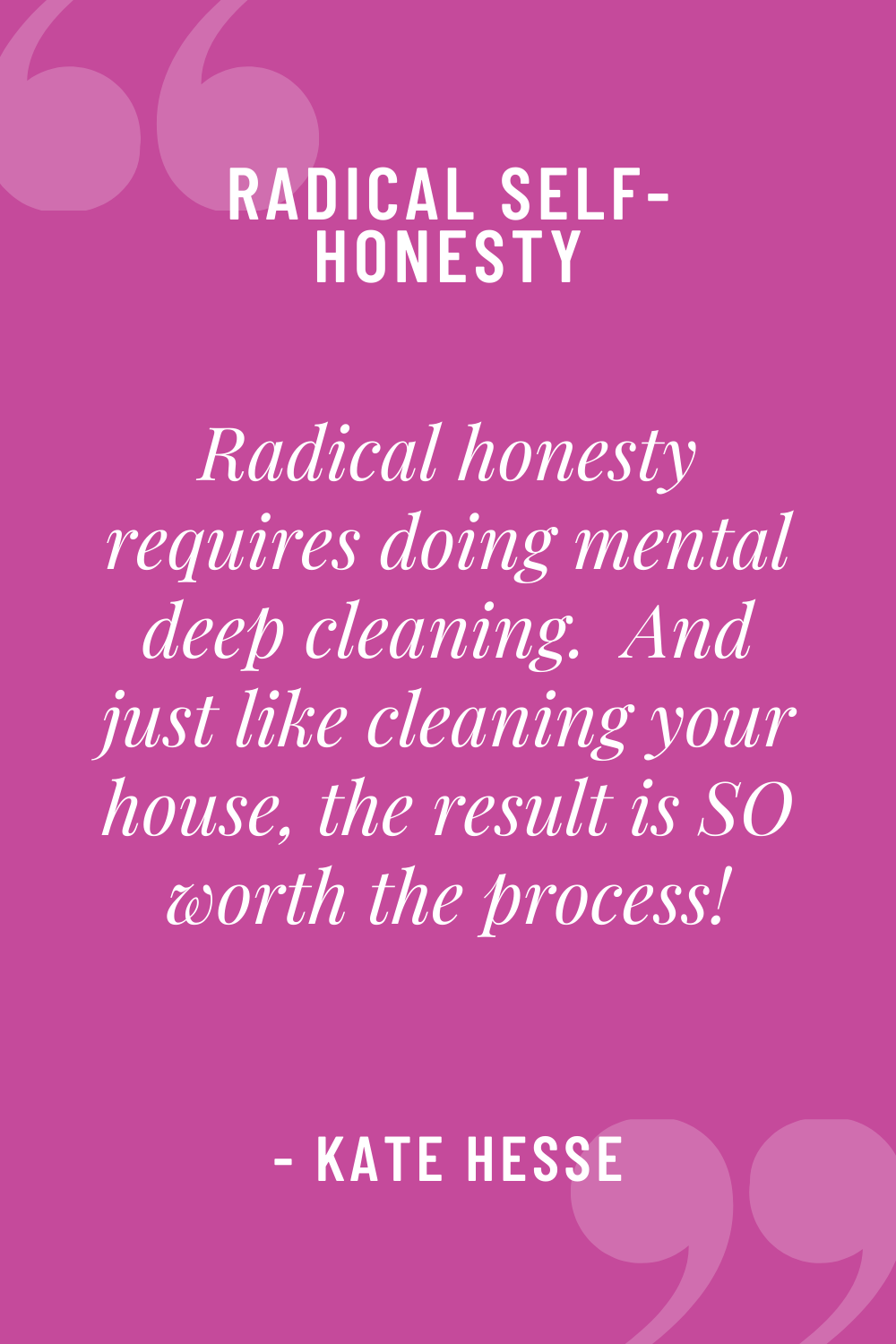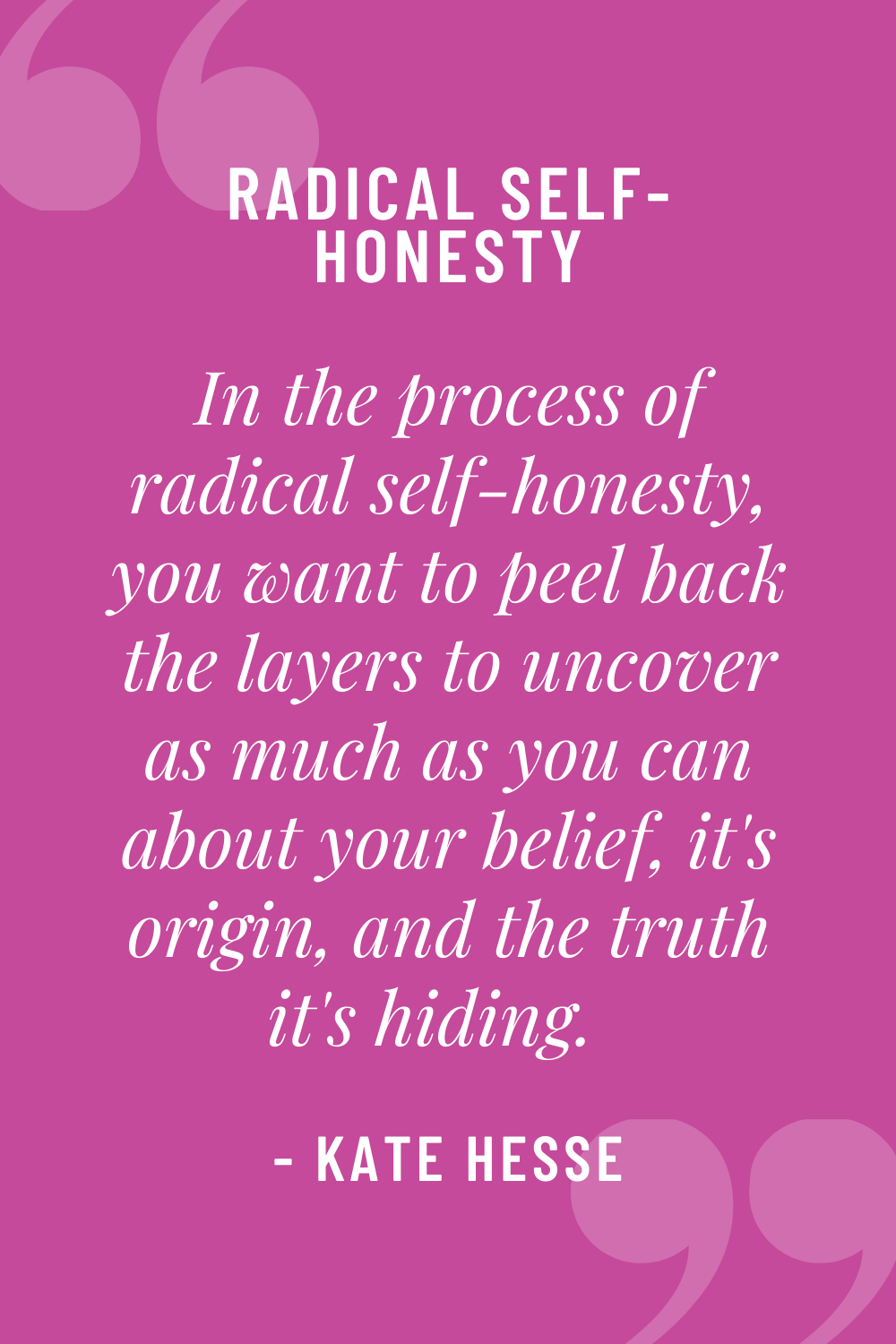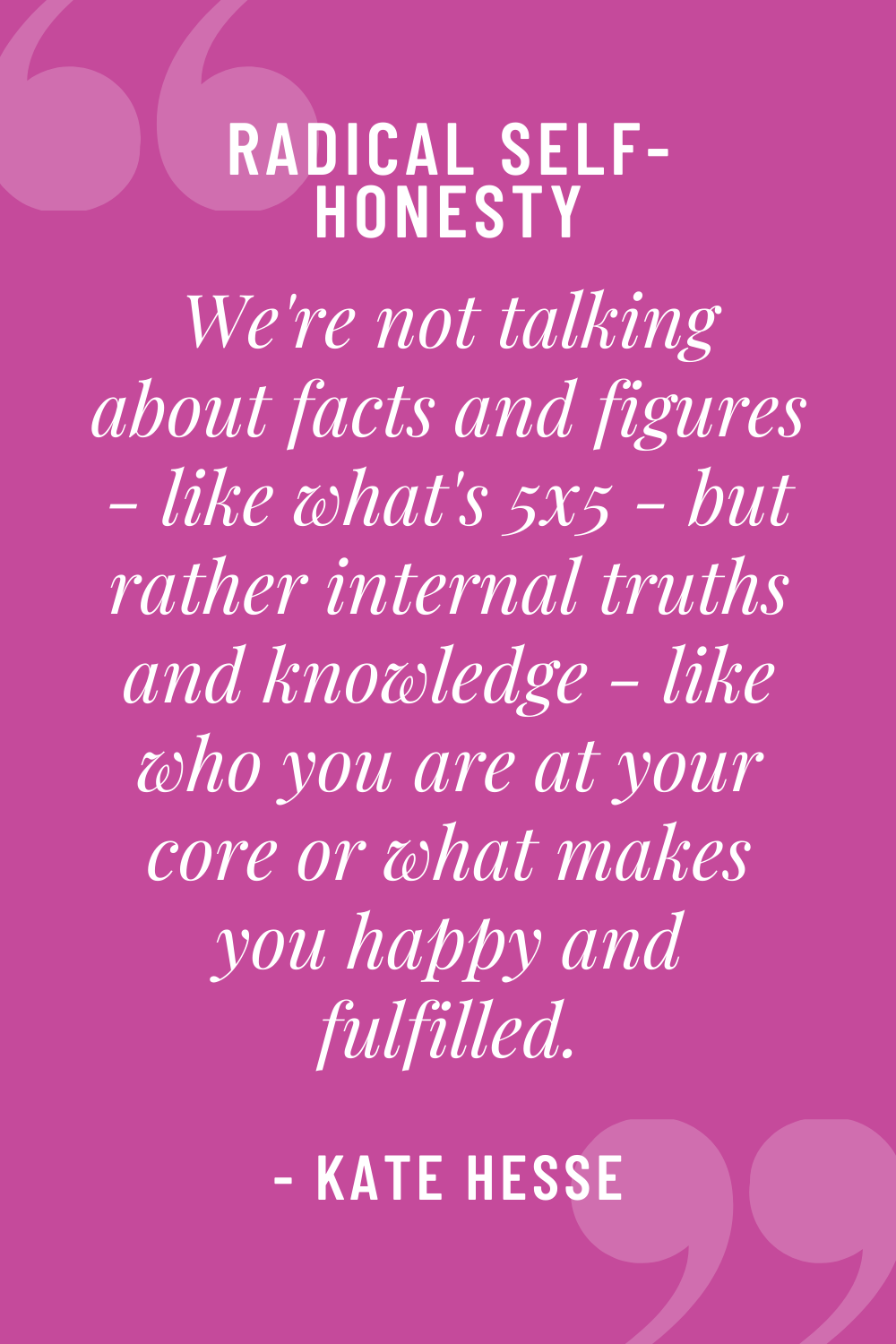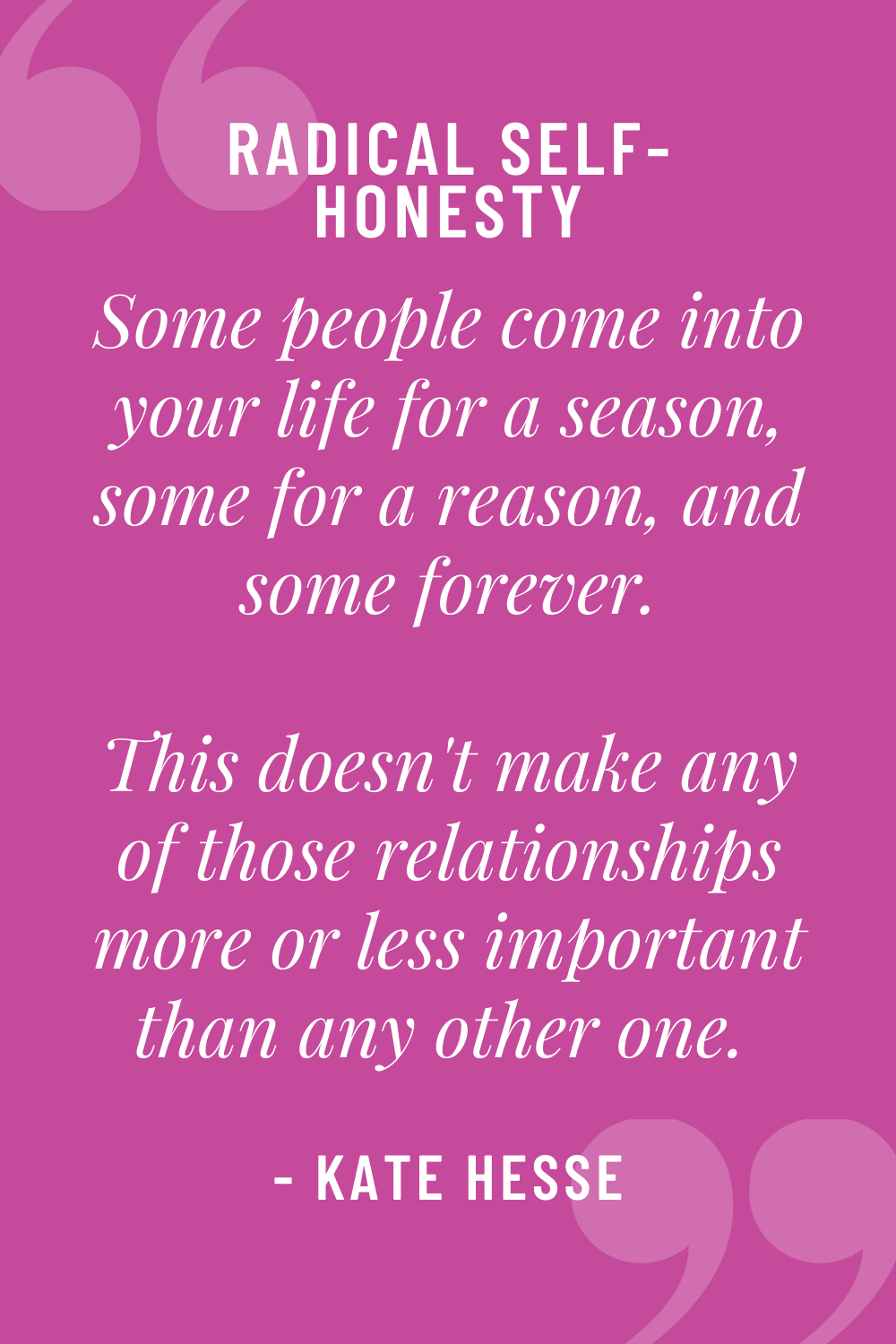Radical Self-Honesty – Improve Your Life (+FREE Radical Honesty Worksheet)
By Kate HesseFirst, I just want to clear up what radical self-honesty is not. We’re not talking about blurting out everything that comes into your head.
When it comes to your interaction with others, the classic rule still applies – before you say anything, ask yourself, “is it honest, is it necessary, is it kind”. If you can’t say yes to all three of those things, it’s best find a way to rephrase it or not to say it at all.
 What we are talking about is getting really brave, cutting through the stories you tell yourself and the beliefs you’ve accepted from your family and society, and uncovering your authentic truths under that giant pile of beliefs.
What we are talking about is getting really brave, cutting through the stories you tell yourself and the beliefs you’ve accepted from your family and society, and uncovering your authentic truths under that giant pile of beliefs.
This work goes hand-in-hand with core values, an energy audit, and boundaries work. Check out those posts to help support yourself in the process of radical self-honesty.
Also, I mention this several times throughout this post, but this is a deep process. Please give yourself grace and ease to move at your own pace.
Truth vs. Belief
I really like the way Katja Maria Vogt approaches this distinction in Belief and Truth: A Skeptical Reading of Plato. In her examination of Greek philosophy, Vogt describes beliefs as deficient cognitive attitudes.
We form beliefs based on experiences. If every time you got out of bed on the left side of the bed and opened the curtains the sun was out, and every time you got out of bed on the right side of the bed and opened the curtains, it was cloudy, you might come to believe that the side of the bed you got out of controlled the weather.
Or if as a child, every time you spoke up someone told you that good girls should be seen and not heard, you might come to believe that in order to be good, you needed to also be quiet.
However neither of those things are truth, they’re just beliefs we created based on experiences.
Again, going back to Vogt examining the work of the stoics: “Acquisition of knowledge, then, would seem to involve moving from having beliefs – states to be gotten rid of – to having knowledge.”
Knowledge is an understanding of truth. It’s something we have to seek out. “It can be hard to access latent knowledge, because it’s buried under false conceptions which first need to be cleared away.”
Identifying Beliefs
So the million dollar question is – how do we know something is a belief and not a truth. I wish we could wear something like a fitness tracker, but instead of counting steps, every time we thought or said something belief based and not truth based it would buzz at us.
Only it isn’t that easy. Identifying your beliefs, finding the truths lost underneath those beliefs, and then realigning your thoughts and actions with those truths is a lifelong journey. And often it’s an uphill battle.
A major tool I use to identify beliefs is to watch my inner (or outer) dialogue for some key words which in my experience indicate I’m going down the road of a belief and not a truth. These are things like:
- I should. . . I ought to. . .
- Good/nice/smart/pretty girls. . .
- My mother/father/friend/partner/teacher told me I was. . .
- Because that’s the way it’s done.
- That’s the way so and so does it.
When you find yourself saying (either aloud or to yourself) any of these indicators, pause for a moment and recognize that you may be basing your actions and thoughts on a belief and not a truth.
Examining Beliefs
Often you’ll catch yourself thinking the above thoughts during the course of your busy day. This is deep introspective work and not something you can do while juggling the hundreds of items on your daily to-do list.
If you notice yourself acting on a belief, do your best to put off making a commitment one way or the other until you’ve had time to examine the belief.
Write the thought down in a notebook, send yourself a text or voice memo, or find some other technique for keeping track of these beliefs. Then set aside some time that day (or that week) to sit quietly and examine the belief.
 When doing the work of examining my beliefs, I prefer to present the belief for examination and then begin a breathwork, meditation or asana practice. Based on my mood, I might also explore the belief through journaling. Experiment to find what works best for you.
When doing the work of examining my beliefs, I prefer to present the belief for examination and then begin a breathwork, meditation or asana practice. Based on my mood, I might also explore the belief through journaling. Experiment to find what works best for you.
During your process of radical self- honesty, you want to peel back the layers to uncover as much as you can about your belief, it’s origin, and the truth it’s hiding.
Consider the statement you made that triggered a “belief alert”. Where did that idea come from? Can you trace it back to a belief you hold? And if so, examine that belief – is it serving you? Or is it something you learned through experience that once served you or perhaps that benefited someone else?
This is the process of radical self-honesty, by pulling back the curtain of the belief, we’re going into some hidden corners of our mind to explore how we came to see the world the way we do. Your beliefs are often long held, most of them were formed when you were a child. They’re your comfort zone. And so it’s natural for this work to feel uncomfortable as you begin to question what may be comfortable but may not longer serve you.
Finding Truth
The truth is inside of you. You had this knowledge before it was covered by a series of beliefs. I like to picture it like the layers of bedding on a bed. First you add a mattress cover onto your mattress. Then a fitted sheet, flat sheet and a blanket. Maybe you hear it is going to be cold that night so you add a few extra blankets to the bed. Then you worry that a storm coming into the area might knock out your power (and heat) so you layer on a few more blankets.
Looking at your bed now, you have no idea that there’s a mattress cover under that giant pile. But if you start to peel away the layers you’ve added on the bed based on guesses and assumptions, you get down to the original bedding.
Similarly, as we peel back our beliefs, we find the truth buried underneath them.
 It’s important to both note and remember throughout this process that truth and knowledge are not things you find outside of yourself. We’re not talking about facts and figures (i.e. what’s the tallest mountain in the world or what’s 5×5) but rather internal truths and knowledge (i.e. who you are at your core or what makes you happy and fulfilled).
It’s important to both note and remember throughout this process that truth and knowledge are not things you find outside of yourself. We’re not talking about facts and figures (i.e. what’s the tallest mountain in the world or what’s 5×5) but rather internal truths and knowledge (i.e. who you are at your core or what makes you happy and fulfilled).
Shedding beliefs will change you
During my orientation at law school one of the teachers or administrators mentioned that a large number of relationships end while one partner attends law school. I believe the theory behind the statement was tied to the long hours and heavy workload. However, I saw a much higher percentage of relationships end or change dramatically during my Yoga Teacher Training than my time in law school.
Law school isn’t designed to fundamentally change who you are as a person. Yoga Teacher Training however asks you to dig deep inside yourself, to explore all the dark places and shadows, and to incorporate everything you find there. While the intent is not to change you as a person, it’s often the result.
This can also be a painful process – as you grow and change, it will impact your relationships with those around you. I heard Contessa Louise Cooper speaking about doing deep self work and I loved the way she described it: “Be you, people will adjust accordingly, or they will remove themselves from your life, and it is okay to let them go.”
 Adam introduced me to a saying which helps me to put this into perspective – “some people come into your life for a season, some for a reason and some forever”.
Adam introduced me to a saying which helps me to put this into perspective – “some people come into your life for a season, some for a reason and some forever”.
If as you begin to do this work, you find some of your relationships no longer fit the person you’re becoming, check out this post which discusses dealing with longer term cycles in our lives.
Before you begin to dig into examining your beliefs, I think it’s important you’re aware that radical self-honesty can be an uncomfortable and sometimes painful process.
However, the results are incredible. I love the way Kelli Russell describes it: “Be radically honest about where you are so you can work from there. . . Kickstart cultivating a life you love and free yourself from the shackles of limiting beliefs.”
I’m ready to do the work, where do I start?
There are two ways to approach this. You can tip toe into the water, or you can dive right into the deep end. There’s no right or wrong way to approach radical self-honesty, the right choice for you is the one that feels right at the moment.
If you want to tip toe into this work, the best way to get started is to identify beliefs as they arise and address them one by one. Work through the sections above on Identifying and Examining your beliefs. As you get more experience with this work, you may find that several beliefs are tangled together, in addressing one, you end up looking at several. Give yourself the time, space and grace to work through beliefs at a pace that’s manageable for you.
Maybe you’re one of those rip the band-aid off quickly people and you want to dive right into the deep end. Or you’ve been tip toeing into this work for a while and feel ready to dive in a little deeper. Download the Radical Self-Honesty Worksheet using the form above and set aside several hours when you can focus your full energy and attention on this work.
I suggest doing a meditation, breathwork, or asana practice before beginning in order to help you connect to yourself. Either working on the worksheet directly or in a journal, explore each question, use them to identify your beliefs and locate the truth under that belief.
After you’ve finished the practice, take time to again practice meditation, breathwork or asana as a way to transition out of this deep work and back into your daily life. You can also break this into multiple sessions and address just one question on the worksheet in each session.
Now that I’ve identified my beliefs, what do I do with them?
Once you’ve done the work of uncovering the truth underneath your beliefs, you’ll want to create a system that works for you to remember that truth. This is especially important as you work to redirect your actions and thoughts toward this newly uncovered knowledge instead of a long held belief.
It might sound silly, but here’s a great example from my own life. I used to believe that it wasn’t okay to leave the house without mascara on. Beneath that daily makeup ritual was the belief that I wasn’t attractive enough to be seen by others with a makeup-free face.
The truth however is that: a. I am beautiful both inside and out regardless of whether I conform to the current commercial view of beauty, and b. No one is paying that much attention to me.
As I worked through this, I made a point of really looking at myself in the mirror each day when I got out of the shower and noticing all the things that make me beautiful on the outside. Then I would smile in the mirror, and think about all the things that make me beautiful on the inside.
Eventually, I got to a point where the old belief had been re-written by the new understanding. This doesn’t mean I don’t care what I look like, it simply means that when I style my hair, put on makeup, pick my clothing and accessories, I do it because those things make me happy, not because I’m trying to fit into what I believe is someone else’s expectation.
Based on the belief(s) you’re working with, you might want to put post-its around the house, schedule daily reminders on your phone, or write out a mantra to use during your regular meditation or breathwork practice. Experiment to find what works for you to help reinforce the truth behind the belief.
This is an ongoing process
Radical self- honesty is an ongoing process. No matter how many beliefs you’ve addressed, there’s always another one popping-up when you least expect it.
If you’re using the tip toe method, continue to identify and work on beliefs as they arise.
If you’re using the dive into the deep end method, you may want to revisit the Radical Self-Honesty Worksheet several times a year. You might do it as part of a new moon ritual each month (or every other month), or at the changing of the seasons. Working it into a celebration practice of leaving behind what no longer serves you and making space for something new will help support this work.
Finally, remember to give yourself grace. This work is often uncomfortable. You want to walk right up to your edge, let your toes dangle in thin air and peer out into the unknown. However, you don’t want to fall off the side of the cliff.
If you’re taking a radical self-honesty practice to a point where you feel like you’re in danger of falling off the side of the cliff, it’s time to take a step back and give yourself some space and grace to find your footing again before diving back in. Remember that this process is a lifelong marathon, not a 100-meter dash.
I want to leave you with a quote I love from an amazing yoga teacher: “Self-compassion is the act of again and again forgiving ourselves for not measuring up to the impossible to reach idealized version of who we think we need to be in order to be loved.” – Lisa Dumas
Do you feel the urge to start tackling this work, but want someone to hold your hand as you travel down this new path? I’d love to help! I now offer two options for one-on-one coaching. If you’re a dip your toes in person, check out my mini-coaching program for Patreon supporters at the Sustainer Level. And if you’re looking for more of a rip the bandaid off approach, check out my Individual Coaching Program.
Related
6 thoughts on “Radical Self-Honesty – Improve Your Life (+FREE Radical Honesty Worksheet)”
Leave a Reply Cancel reply
This site uses Akismet to reduce spam. Learn how your comment data is processed.
[…] yourself feels right to you! If you are struggling with this, I suggest checking out my posts on: radical honesty and self-compassion to help you tune into the voice of truth inside you while tuning out the mean […]
[…] Check out this post for an overview on beliefs. […]
[…] you’ll find that negative self-talk or unconscious beliefs are undermining your ability to achieve your goals (check out the linked posts for more […]
[…] Learn more about identifying your “shoulds”. […]
[…] out these posts on Core Values and Radical Self-Honesty to help you identify what’s truly important to you. And stay tuned for next weeks episode […]
[…] Grab your copy of the Personal Energy Audit Worksheets using the form above. Start by filling in your core values and your myths. […]